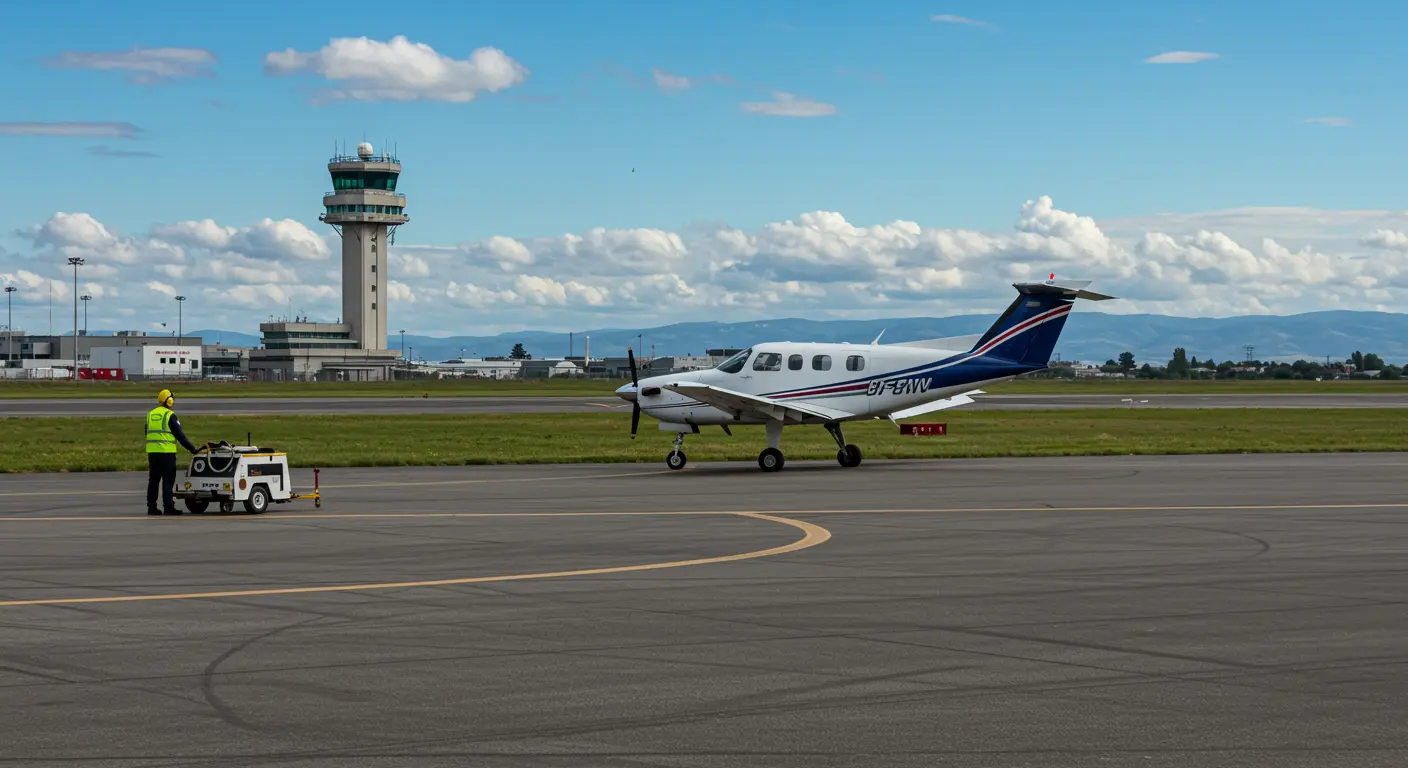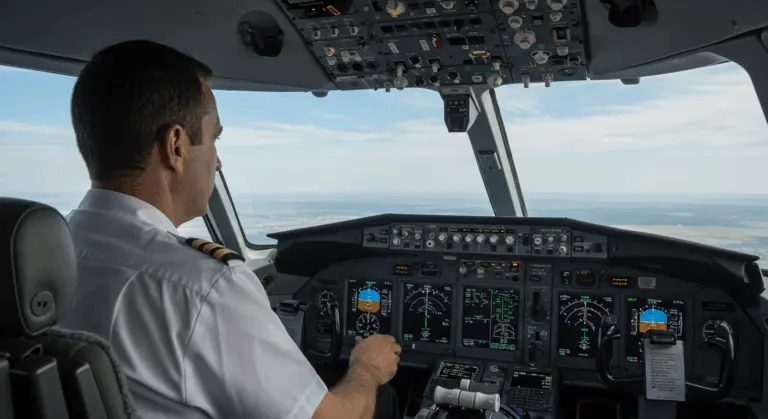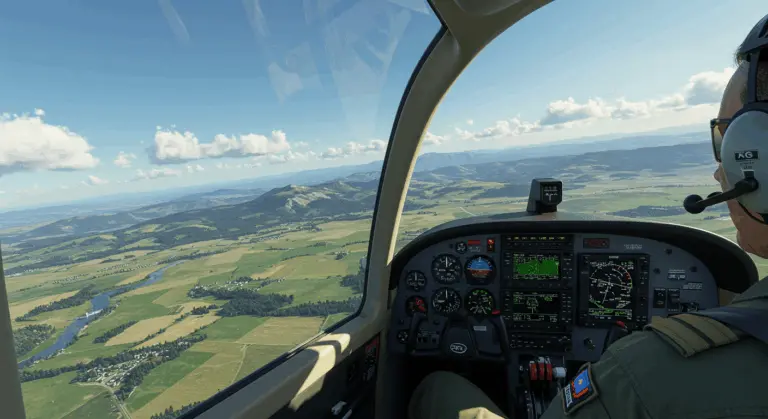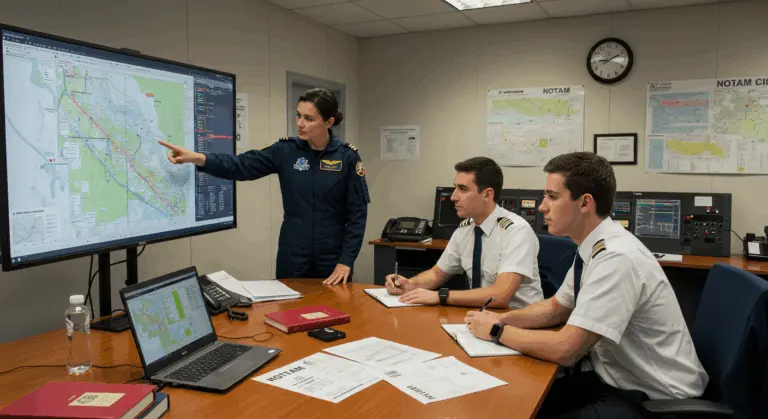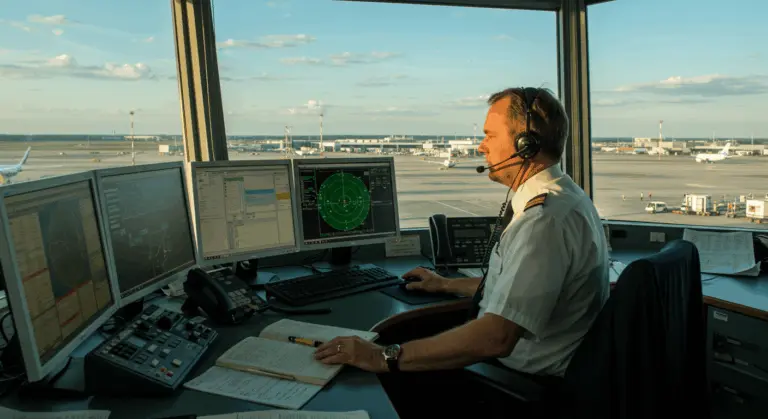Understanding the LDA Approach in Aviation
What is the LDA Approach?
The LDA (Localizer Directional Aid) represents a specialized non-precision instrument approach designed for airports where challenging terrain or obstacles make standard straight-in alignments impossible. Unlike precision approaches, it delivers only horizontal guidance through a ground-based radio beam intentionally offset from the runway centerline. This intentional misalignment requires pilots to make a critical transition from instrument flight to visual navigation to properly align with the runway before touchdown.
How LDA Approaches Work
An LDA approach employs a ground-based localizer transmitter, broadcasting an approach course intentionally offset by more than 3 degrees from the runway centerline. Despite this angular deviation, the signal maintains a course width comparable to standard localizers, establishing a precise lateral pathway for aircraft to track.
Pilots track this offset localizer signal using standard navigation instruments. Throughout their descent, they must maintain constant awareness that their flight path doesn’t align with the runway—a critical distinction requiring a final visual maneuver. This might involve either a subtle course correction or a complete circling approach to achieve proper landing alignment.
Without the vertical glideslope component found in ILS approaches, LDA procedures place complete altitude management responsibility on the pilot, who must navigate using step-down fixes and strictly adhere to published minimum altitudes.
LDA Approach Procedures
LDA approach procedures guide aircraft to a critical decision point where pilots must transition to visual references for landing. The challenge? That angular offset demands precise final adjustments before touchdown.
A typical LDA approach begins with intercepting the localizer course, often via a feeder route or designated transition. Pilots then track the localizer inbound while maintaining published altitudes at various fixes along the approach path. Without vertical guidance, they manage their descent using step-down fixes—specific waypoints where altitude restrictions progressively decrease as the aircraft approaches the runway.
The most difficult part of LDA procedures? That final runway alignment. When the offset angle exceeds 30°, approaches will only publish circling minimums, requiring pilots to visually maneuver after reaching the Minimum Descent Altitude (MDA). This circling maneuver increases complexity considerably, particularly when weather conditions hover near minimums.
California’s Van Nuys LDA-C approach demonstrates this operational complexity. This approach requires pilots to follow the offset localizer course and then execute a significant turn to align with the runway for landing. Such procedures demand exceptional flying precision and meticulous preparation for that critical instrument-to-visual transition.
Every LDA approach incorporates specific missed approach procedures—mandatory escape routes pilots must execute when visual references cannot be established at MDA or when safe landing completion becomes questionable. These procedures typically involve a climbing turn away from terrain, followed by holding at a designated fix until the next approach attempt or diversion to an alternate airport.
LDA vs LOC: Key Differences
The fundamental distinction between LDA and LOC (Localizer) approaches centers on their relationship to the runway centerline. Both utilize similar ground-based radio technology for horizontal guidance, yet they serve distinctly different operational roles in challenging airport environments.
Standard LOC approaches align directly with runway centerlines, creating intuitive straight-in paths that naturally funnel aircraft toward touchdown zones. This alignment makes the transition from instrument flying to visual landing relatively straightforward, as the aircraft is already positioned for landing once visual references are acquired.
From a pilot’s operational perspective, LDA approaches demand additional planning and heightened situational awareness compared to standard LOC procedures. Pilots must anticipate that crucial turn to final alignment while ensuring adequate visibility exists to complete the maneuver safely. This fundamental difference makes LDA approaches more challenging—especially when weather conditions approach minimums and visibility becomes marginal.
Safety Considerations for LDA Approaches
The non-precision nature and offset alignment of LDA approaches present unique safety challenges requiring heightened pilot awareness and thorough preparation.
The primary safety concern? That critical transition from instrument guidance to visual references. Pilots must execute a turn to align with the runway after becoming visual—a maneuver that becomes particularly demanding when visibility hovers at minimums. Limited time remains to configure the aircraft for landing while simultaneously executing the alignment turn.
Approaches exceeding 30-degree offsets mandate circling minimums. These circling maneuvers statistically present higher risk profiles than straight-in approaches—low-altitude maneuvering combined with potentially marginal visibility creates a challenging operational environment.
Missed approach procedures are essential during LDA operations. Pilots must be thoroughly familiar with these procedures before commencing the approach, as the combination of an offset course, potentially challenging terrain, and the need to transition to a climbing profile can create a high-workload environment if a go-around becomes necessary.
Terrain awareness represents another critical safety factor. Many LDA approaches exist precisely because terrain prevents straight-in approach alignments. Consequently, deviations from published approach courses can rapidly lead to terrain conflicts—especially problematic during low visibility conditions or nighttime operations.
To reduce these risks, experienced pilots employ several essential practices: thorough approach briefings, strict adherence to published procedures, and conservative decision-making that often includes applying personal or company buffers beyond published weather minimums. These self-imposed restrictions recognize that—regulatory minimums represent absolute operational floors, not necessarily optimal conditions for safe flight.
LDA Approach Minimums
LDA approach minimums establish the lowest altitude and visibility thresholds under which pilots can legally attempt approach completion and landing. These parameters ensure adequate obstacle clearance while providing sufficient visual references for the critical final landing phase.
LDA approaches typically publish Minimum Descent Altitudes (MDA) rather than Decision Heights (DH)—a distinction reflecting their non-precision characteristics. The MDA represents the lowest altitude to which descent is authorized without establishing the required visual references for landing. Pilots must maintain this altitude until either acquiring the necessary visual cues or initiating a missed approach.
Visibility requirements fluctuate based on approach design, aircraft category, and applicable minimums type. Circling minimums—mandatory for offsets exceeding 30 degrees—demand enhanced visibility to ensure safe visual maneuvering.
| Approach Type | Standard Alternate Minimums |
|——————————–|——————————————|
| Non-Precision (LDA, VOR, etc.) | 800-foot ceiling and 2-mile visibility |
| Precision (ILS, PAR, GLS) | 600-foot ceiling and 2-mile visibility |
Conclusion: The Role of LDA in Aviation
The Localizer Directional Aid (LDA) approach serves as an indispensable navigation procedure, providing instrument access to airports where challenging terrain or obstacles render standard straight-in alignments impossible.
As non-precision approaches, LDA procedures provide significant operational value by greatly expanding the network of instrument-accessible airports. Commercial operators benefit from improved schedule reliability. General aviation gains enhanced operational flexibility.
The distinctive design of LDA approaches—particularly that deliberate offset from runway centerline—demonstrates the ingenuity of aviation navigation system designers confronting geographical constraints. Rather than simply declaring certain airports unsuitable for instrument approaches, these offset procedures offer practical solutions that carefully balance safety imperatives with operational necessity.
For pilots, mastering LDA approaches greatly expands instrument flying capabilities. Required skills build upon fundamental competencies while introducing additional complexity:
-
Precise tracking of the localizer course
-
Disciplined altitude management without vertical guidance
-
A smooth transition to visual references for final alignment
As aviation evolves toward increasingly sophisticated navigation technologies—particularly GPS-based performance-based navigation (PBN) approaches—ground-based aids like Las may gradually diminish at certain locations. However, their continued presence in the national airspace system provides both redundancy and alternatives when satellite-based systems are unavailable.
The LDA approach demonstrates to aviation’s commitment to maximizing safety while expanding operational capabilities. By providing structured, repeatable pathways to airports with challenging surroundings, these approaches enable pilots to safely navigate to critical decision points where visual references become available for landing completion. They connect communities despite formidable geographical challenges—an important achievement in aviation accessibility.

